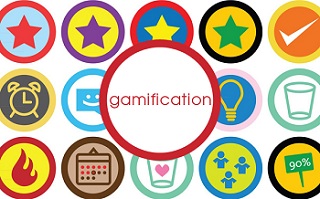Gamification - a fresh look at user motivation?
 Gamification is now a very popular topic. In this topic, we will try to figure out what it is and also convince ourselves and others that gamification is just a buzzword.
Gamification is now a very popular topic. In this topic, we will try to figure out what it is and also convince ourselves and others that gamification is just a buzzword.What is this?
According to the popular definition, gamification is the use of game elements and game design techniques in a non- game context . Elements of gamification can be:
- Glasses
- Badges
- Awards
- Progress Bars
- Levels
- Avatars
- Quests
- Leaderboards
- and much more
However, if everything were limited to embedding game elements, gamification would not be considered as a separate area of knowledge. Undoubtedly, on some elements you will not get far.
It is not enough every time when authorizing a user to give him 100 points and to hang inside the leaderboard system with a list of the best. It is necessary to answer the question: “Why are these glasses needed?”. If a user registers on the site, starts in the rating from a position in the region of one million, it will initially be clear to him that he will be able to lead the rating at best in a few years, and such elements of gamification will only have a demotivating effect.
')
In addition, the main condition for successful gamification is the user's goodwill (no one forces you to play poker with friends) and the opportunity to work with the system in a “boring” mode.
It would seem that the school is ideal for the gamification model. Here and levels (classes), and the development of different skills (subjects), awards (evaluation), the battle with the boss (offsets, exams). However, this is not gamification for several reasons. Firstly, this game is compulsory and obligatory, and secondly, the cost of loss is not a toy at all, but it radically affects the whole destiny of a person.
A bit of history
You should not take gamification as a completely new invention, entirely belonging to the digital era. Back in 1912, Cracker Jack started putting toys into their popcorn packs to attract more attention from customers. Such a move is still one of the most favorite tricks of marketers working in the field of food sales.
In 1979, Texas International Airlines launched the first customer loyalty program, the idea took root, and until now people have been flying specifically with one company to accumulate points or miles and get a free flight or the opportunity to transfer to a business class.
Gamification became widespread in the middle of the zero years, when it was used to solve business problems.
However, this approach gained its present popularity (of course!) In 2010, in the golden time of the social network Foursquare, which actively used a competitive motive.
Game design techniques
It is obvious that for the introduction of game elements in your project you will need to think like a game designer.

This means that you need to think out the answers to many questions. For example, how to make the game elements interact with each other? How to make each element in the system in its place? Why is it necessary to give achivku and not a badge?
To get involved in the game, you need to create a competitive environment - if people need to compete, they use the system more actively. However, the competition process should not strain users. To achieve proper gamification, the following conditions must be met:
- The victory should be achievable (for example, everyone can get into the top users of the habr - you just have to write some good articles);
- Competitions should have simple and clear rules, and they should be (a very important point!);
- they should be transparent and not too hard.
The game should be fun, fan; For this you need to use game mechanics, of which there are several types . For example:
- Theory of the gradual presentation of information. Remember, in any game tutorial information is always served in steps and in small portions. So new knowledge is easier to remember, plus more interesting - the user is constantly learning something new, and does not receive a bunch of incomprehensible information at once.
- The introduction of some "deterrents" or a system of fines, demotivators, giving excitement. For example, skipping a move in monopolies, or, returning to Habr, the probability of getting minuses for a bad article.
In any case, it is important not to forget why everything is done at all, otherwise the risk is high in the end to make a game, and not to introduce gamification into a real project to solve any problem.
Using game elements in a non-player context
The context can be any, but we should not forget about the goals of users. They do not storm the castle, but use your website in the hope of obtaining the necessary information or service. Gamification is only a tool to motivate the user. She encourages him to any action.
It would be appropriate to talk about motivation.

Conventionally, motivation can be divided into internal (performing actions for the sake of the actions themselves, for example, a hobby) and external (actions are performed not for pleasure, but for the sake of achieving the goal). If you are not ready to cut off users by their hobbies (for example, to make a tourist portal only for sudoku lovers), then it is the external motivation that is the object of gamification:
- Status - the action is performed to satisfy vanity, to obtain the approval of other people. For example, write an interesting post and become the leader of the user rating on Habré, get an exclusive badge, which ordinary mortals do not have (again, badges "author", "translator", "troll", etc.
- The rights. at the same Habré, you can get full access to the site only by getting an invite, which can be earned by writing an article in the sandbox;
- Power - actions are performed to obtain opportunities that others do not have (for example, the strength of the voice on Habré - you can tick off the unwanted hard);
- Material values (prizes).
However, one must be careful not to come to a situation where external motivation completely replaces the internal one. If you are given bonuses every time you brush your teeth, you will eventually stop brushing your teeth due to the fact that it is useful, and you will do it only for bonuses. And if the bonus does not, your teeth will fall apart.
Stages of development of a gamified system
Kevin Werbach and Dan Hunter lead the model by which the gamification system should be built. So, it is necessary:
- Identify business goals, the achievement or failure of which will determine the success or failure of the project. Getting 20 badges per month by users is not a goal. Increasing site traffic and user engagement is the goal.
- Determine the desired end user behavior.
- It is necessary to clearly describe the players. Demographic characteristics, categories of site visitors, their interests. What do they want.
- Think of the so-called loop activity. They are divided into loops of engagement (perception at the micro level: motivation to action - action - feedback, which is a kind of one of the motivators for committing new actions) and progress loops (globalized engagement loops). For example, a user bought a new tank in the game - as a feedback, he received not only more firepower, but also the possibility of buying the next tank. By collecting several tanks, the user gets the opportunity to command the entire division, and at the end of the game - the army.
- Do not forget about the fan. Remember: users should have fun.
- Select game elements. Which ones will help you achieve your goals? For example, using a leaderboard will help (yes, it will only help) in creating a competitive environment, and the progress bar will make the system more transparent: the user will always see how much he has left before receiving a new level.
Example
A great example of gamification is Microsoft's Ribbon Hero 2 . In fact, this is an add-on for MS Office, which motivates users in a gaming manner to undergo training on the use of an office suite. Fan is researching something new.

We decompose the gamification in this example into points.
So, we can assume that the business goals here are:
- introduce users to the Ribbon;
- to help them overcome the threshold of entry due to simple actions (answers to simple questions, performing simple tasks, etc.).
Target user behavior is to effectively use MS Office. Another goal: to develop in the user awareness of himself as the "guru of MS Office". A user who considers himself a “god” in the management of the Word will probably not switch from MS Office to Google Docs for purely psychological reasons.
You can describe the players as unfamiliar with the office suite of people, or as users of the old (no-boron) versions of the office.
Activity loops are implemented here thanks to a progress scale, through which the user can track his results and their dynamics.
The fun of the game is:
- researching something new;
- confidence that soon it will be possible to reach the level of "MS Office gurus".
Game elements
- small goals - to complete the task;
- medium goals - go to a new level;
- the global goal is to arrange a paper clip for work (according to the plot Clippy - an animated character from the MS Office help - was fired, and the task is to find him a job again);
- Badge to achieve the goal.
Why is gamification sucking?
So we got to the most interesting :). Why, with all the seeming benefits and interestingness of this method, is gamification just fun?
To begin with, the effectiveness of this method is very doubtful. There are practically no studies confirming this very effectiveness with specific examples. In our experience, gamification often only hurts and leads to reduced user engagement.
Gamification can also serve as a means of deceiving people. There is a great temptation to slip users, instead of improving the service or service, which do not give badges and awnings, which unreasonably increase self-esteem.
In addition, in fact, gamification does not exist at all! Everyone is trying to add elements of gamification to their site, however, after a detailed study of the issue, it comes to understand that we are dealing only with the usual interaction design and using well-known psychological principles of motivation (achievement, recognition, novelty). In the digital industry, the gaming industry has mastered these principles before others. But from this they do not become game! It turns out that it is simply not necessary to single out gamification in a separate discipline - this is the usual psychology.
In the next article, we will demonstrate with concrete examples from life that gamification is difficult to apply when executing projects that require a guaranteed result (that is, in most commercial projects) and consider a situation where the use of this method is quite the opposite.
Thank you all for your attention! We will be happy to answer questions in the comments.
PS The thoughts voiced in this topic formed the basis of the presentation that Vladimir Zimin ( darkspi ) from the UIDesign Group presented at the professional Microsoft Design Camp conference in Moscow not so long ago.
Source: https://habr.com/ru/post/165779/
All Articles